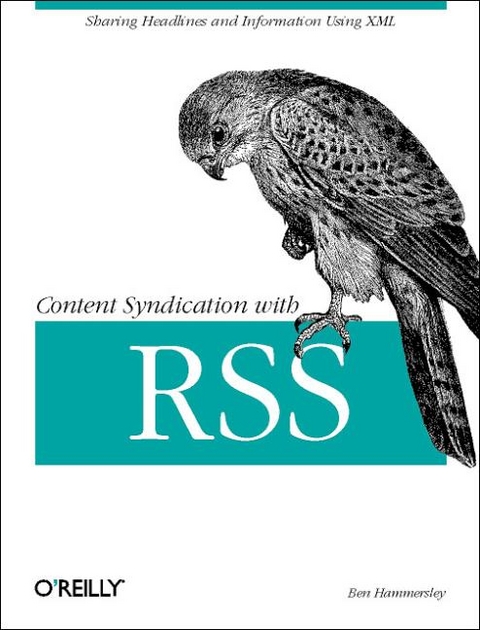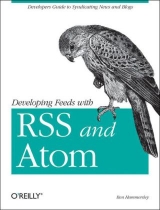
Content Syndication with RSS
O'Reilly Media (Verlag)
978-0-596-00383-8 (ISBN)
- Titel ist leider vergriffen;
keine Neuauflage - Artikel merken
Originally developed by Netscape in 1999, RSS (which can stand for RDF Site Summary, Rich Site Summary, or Really Simple Syndication) is an XML-based format that allows Web developers to describe and syndicate Web site content. This text offers webloggers, developers, and the programmers who support them a thorough explanation of syndication in general and RSS in particular or Web developers who want to offer XML-based feeds of their content, as well as developers who want to use the content that other people are syndicating, the book explores and explains metadata interpretation, different forms of content syndication, and the increasing use of Web services in this field. If you're interested in producing your own RSS feed, this step-by-step guide to implementation is the book you'll want in hand. RSS is sprouting all over the Web, connecting weblogs and providing news feeds. Originally developed by Netscape in 1999, RSS (which can stand for RDF Site Summary, Rich Site Summary, or Really Simple Syndication) is an XML-based format that allows Web developers to describe and syndicate Web site content.
Using RSS files allows developers to create a data feed that supplies headlines, links, and article summaries from a Web site. Other sites can then incorporate them into their pages automatically. Although RSS is in widespread use, people struggle with its confusing and sometimes conflicting documentation and versions. This concise volume begins with an introduction to content syndication on the Internet: its purpose, limitations, and traditions, and answers the question of why would you consider "giving your content away" like this? Next, the book delves into the architecture of content syndication with an overview of the entire system, from content author to end user on another site. You'll follow the flow of data: content, referral data, publish-and-subscribe calls, with a detailed look at the protocols and standards possible at each step. Topics covered in the book include: creating XML syndication feeds with RSS 0.9x and 2.0; beyond headlines - creating richer feeds with RSS 1.0 and RDF metadata; using feeds to enrich a site or find information; publish and subscribe: intelligent updating; news aggregators, such as Meerkat, Syndic8, and Newsisfree, and their Web services; and alternative industry-centric standards.
Ben Hammersley is an English emigre, living in Sweden, with his wife, three greyhounds, a few hundred deer, and a two-way satellite connection. For a day job, he writes for the British national press, appearing in The Times, The Guardian and The Observer, but in his free time, he blogs excessively at www.benhammersley.com and runs the Lazyweb.org ideas site. As a member of the RSS 1.0 Working Group, he survived the Great Fork Summer, and as a journalist he has been accosted by the secret police of two countries. To this day, he doesn't know which was worse.
Preface 1. Introduction What Is Content Syndication? A Short History Why Syndicate Your Content? Legal Implications 2. Content-Syndication Architecture Information Flow and Other Metaphors And at the Other End Structuring the Feed Itself Serving RSS 3. The Main Standards RSS 0.91 RSS 0.92 RSS 2.0 RSS 1.0 4. RSS 0.91, 0.92, and 2.0 (Really Simple Syndication) RSS 0.91 RSS 0.92 Creating RSS 0.9x Feeds Once You Have Created Your Simple RSS Feed 5. Richer Metadata and RDF Metadata in RSS 0.9x Resource Description Framework RDF in XML 6. RSS 1.0 (RDF Site Summary) Walking Through an RSS 1.0 document The Specification in Detail Creating RSS 1.0 Feeds 7. RSS 1.0 Modules Module Status 8. RSS 2.0 (Simply Extensible) The Specification in Detail Module Support Within RSS 2.0 Producing RSS 2.0 with Blogging Tools 9. Using Feeds Using RSS Feeds Inside Another Site Other Outputs and Selective Parsing 10. Directories, Web Aggregators, and Desktop Readers Directories: Introducing Syndic8 Web Aggregators: Introducing Meerkat Desktop Readers 11. Developing New Modules Namespaces and Modules with RSS 2.0 Case Study: mod_Book Extending Your Desktop Reader Introducing AmphetaDesk 12. Publish and Subscribe Introducing Publish and Subscribe Rolling Your Own: LinkPimp PubSub LinkpimpClient.pl A. The XML You Need for RSS B. Useful Sites and Software Index
| Erscheint lt. Verlag | 29.4.2003 |
|---|---|
| Zusatzinfo | index |
| Verlagsort | Sebastopol |
| Sprache | englisch |
| Maße | 179 x 233 mm |
| Gewicht | 364 g |
| Einbandart | kartoniert |
| Themenwelt | Mathematik / Informatik ► Informatik ► Web / Internet |
| ISBN-10 | 0-596-00383-8 / 0596003838 |
| ISBN-13 | 978-0-596-00383-8 / 9780596003838 |
| Zustand | Neuware |
| Haben Sie eine Frage zum Produkt? |
aus dem Bereich



